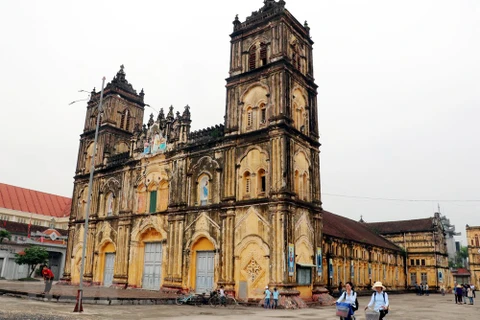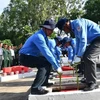 Bui Chu Church, one of the most magnificient old churches in the north of Vietnam, is in a state of serious disrepair. (Photo tintucnamdinh.vn)
Bui Chu Church, one of the most magnificient old churches in the north of Vietnam, is in a state of serious disrepair. (Photo tintucnamdinh.vn) Hanoi (VNS/VNA) - The Relics Preservation Institute, after examining 134-year-old Bui Chu Church in the northern province of Nam Dinh, has proposed two possible renovation plans to the Ministry of Culture, Sports and Tourism.
The church, located in Xuan Ngoc commune, Xuan Truong district, Nam Dinh province, was built in the late 19th century by Spanish Bishop Wenceslao Onate Thuan. It was inaugurated in 1885 and renovated in 1974 and 2000.
The first solution aims to maintain the original structure and remove damaged parts to fix or replace them, while the second option would see the church torn down and replaced by a new structure modelled off the original.
Under the first plan, for example, workers would remove broken roof tiles. They would re-use ones that can be salvaged and replace those that cannot with new tiles designed based on the old ones.
The workers would fix the damaged cement border on the roof to look like the original architecture.
The worm-eaten wooden pillars would be replaced by wood of the same kind and cracked walls would be fixed, maintaining their original decoration patterns.
The foundation would be strengthened to save the inclined bell tower and walls. The old floor tiles would be replaced by new ones based on the originals.
According to experts from the institute, this solution would not last very long and further renovation would be needed every year. It also would not meet the demand for a larger space for gatherings inside the church.
The second solution involves pulling down the whole building including the old foundation and floor. Workers would build a new foundation using advanced techniques to ensure the building will last longer.
The new church would mimic the old structure but would be slightly larger.
The new building would reuse metal decoration frames, preserve tombs of priests and use renovated gold-gilded decorations, old stone stelae and two bronze bells.
The institute said the second solution would be more stable and long-lasting.
“It preserves basic features and typical values of the original church while meeting demands of the community for a larger area at a reasonable price,” the report to the culture ministry reads.
The institute proposed the ministry choose a highly qualified agency with experience in renovating relics and building religious buildings. The chosen agency should make a detailed plan before dismantling any of the building.
As the ministry consults experts to choose between the two options, some architects have expressed concerns.
Nguyen Hanh Nguyen, a lecturer at HCM City Architecture University, told Thanh Nien (Young People) newspaper she had voted for the first solution.
“This solution keeps the key values of the building and avoids destroying materials that cannot be replaced,” she said. “This solution preserves symbols of culture and history proving the initial period when Christianity was introduced in Vietnam. This is a way of preserving originality.”
She said she was worried that after destroying the walls and foundation, it would be impossible to find workers talented enough to recreate the old structure.
“We always remake buildings that were totally destroyed by fire or bombs,” she said. “This is an intact building.”
Architect Nguyen Ngoc Hoai Nam, a member of Yeu Di San (Love Heritage) Group, said he believes the first solution will cost much less than the second option.
Nam also suggested another solution: preserve the existing church while building a new building next to the old one.
“We will both keep the old one and have a more spacious area for the increasing demands of the local community,” he said.-VNS/VNA




















